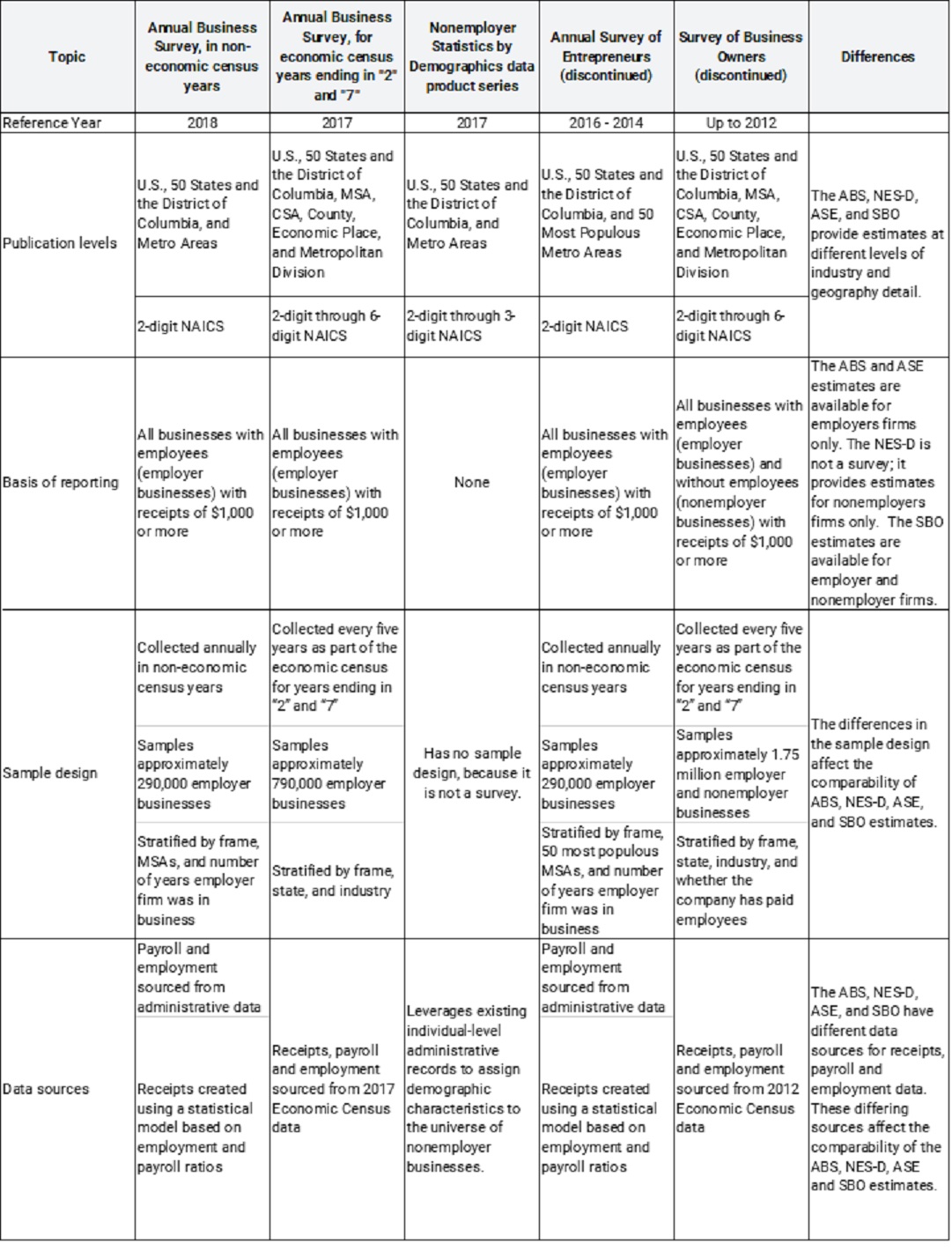Guidance for Data Users
Guidance for Data Users
Using Data.Census.gov
For information on using data.census.gov to access ASE data, please refer to the general FAQ linked below.
Comparability to the Survey of Business Owners
The Annual Survey of Entrepreneurs supplements the Survey of Business Owners, which collects economic and demographic characteristics every five years. The ASE, however, has significant differences that affect the comparability between the two programs. Conducting the ASE allows for a more frequent collection of economic and demographic characteristics data. The ASE has a smaller sample size focused on employer businesses and is designed to measure the number of years a firm has been in business, while the Survey of Business Owners has a much larger sample size designed to provide more geographic and industry detail. The Survey of Business Owners uses data collected from the economic census to produce estimates. However, the same detailed data are not available during non-economic census years. As a result, the methods used to create estimates for the ASE differ from those of the SBO. For more information on the ASE methodology, refer to the technical documentation.
At-a-Glance: Annual Survey of Entrepreneurs and Survey of Business Owners
Click to Enlarge
Comparability to the Management and Organizational Practices Survey
The 2015 ASE included additional questions on business management practices. The questions were based on the Management and Organizational Practices Survey (MOPS). Data users should be aware of differences between the MOPS and the ASE. The surveys differ in industry coverage and scope.
The MOPS primarily targets manufacturing sectors, while the ASE targets businesses operating in 20 different NAICS sectors. The MOPS selects mostly multi-unit and large single-unit businesses, while the ASE oversamples young businesses. Additionally, the MOPS is conducted on an establishment basis while the ASE is a firm based survey.
Questions from the MOPS cover a broader range of management practices topics than the ASE. The MOPS also includes detail on differences in practices related to managers versus practices related to non-managers. While the ASE used questions from the MOPS, questions were edited to be more applicable to the types of businesses covered in the ASE. The ASE also added response options to allow the respondent to indicate the questions does not apply to their business.
Due to the differences in coverage and scope, data from the ASE are not comparable to data from the MOPS.
More information about the Management and Organizational Practices Survey can be found on the MOPS website https://www.census.gov/mcd/mops/.
Comparability to Business Dynamics Statistics
There are known differences between the Business Dynamics Statistics (BDS) and the Annual Survey of Entrepreneurs (ASE). The two products differ in purpose, data sources, scope, industry coverage, and methodologies in ways that affect the comparability between the two sets of statistics.
The ASE provides annual data on select economic and demographic characteristics of employer businesses and their owners by sex, ethnicity, race, and veteran status. The BDS provides a longitudinal source of data on businesses that can be tracked over many years.
The ASE is a sample survey of approximately 290,000 employer businesses and the BDS compiles data from the entire set of private non-farm employer businesses in the Longitudinal Business Database (LBD).
In scope to the ASE are employer firms that have annual payroll greater than 0. In scope to the BDS are businesses with employment during the pay period including March 12, so the BDS statistics exclude some businesses that are in scope for the ASE.
The ASE is based on the 2012 North American Industry Coding System (NAICS) and covers 20 NAICS industries. The BDS is tabulated based on the Standard Industrial Classification (SIC) and provides statistics by 9 SIC sectors.
Both the BDS and the ASE provide statistics by firm age. The BDS measures firm age using information from the Longitudinal Business Database (LBD) , which links annual snapshot files from Census Bureau's Business Register (BR) to provide a history for each establishment. More information on the linkage process is available on the BDS website.
//www.census.gov/ces/dataproducts/bds/methodology.html#datasource




